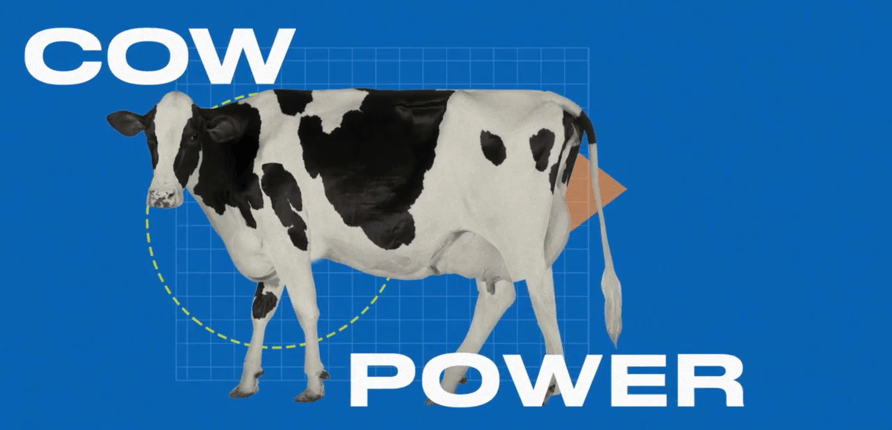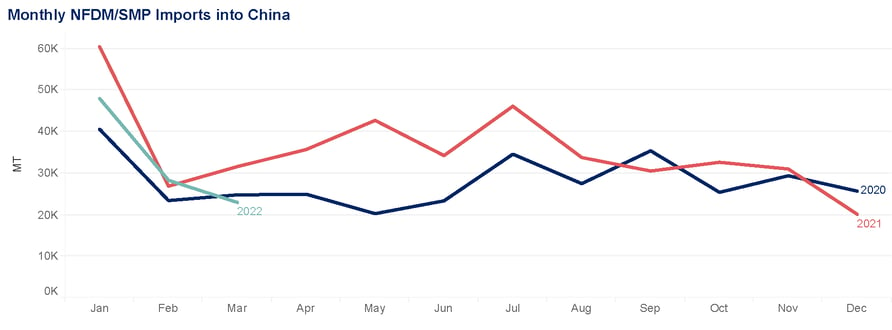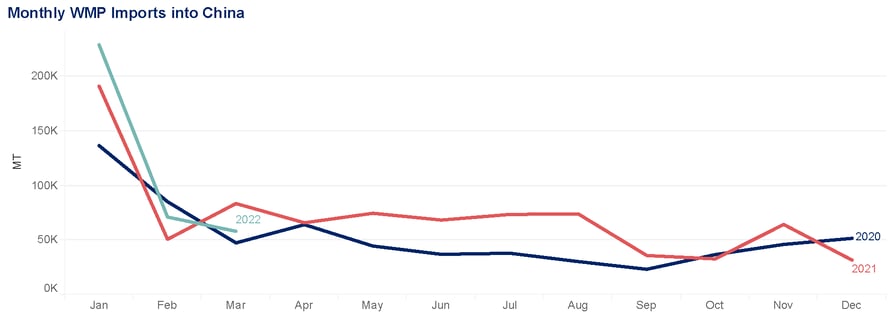HIGHLIGHTS: April 22, 2022
• Calls to revive OSCAR
• Gardner named US-IDF chair
• U.S. dairy shines during Earth Week
• Mexican border crossings resume operations
• Market Summary: uncertainty sinks GDT
• EU sees flat milk deliveries in 2022
• USDEC Data Hub: China milk powder
• Chinese dairy imports dive in March
• Latest on China’s COVID lockdowns
• USDEC submits TRQ comments to Canada
• Letter to OSRA conferees
• Company news: Lavazza, Halo Food
Featured
U.S. dairy calls for supply chain relief starting with OSCAR reports
USDEC and NMPF sent a joint letter to USDA Secretary Tom Vilsack and Transportation Secretary Pete Buttigieg outlining a series of suggestions to address the ongoing supply chain crisis, starting with the reviving of the Agriculture Marketing Service’s (AMS’s) Ocean Shipping Container Availability Report (OSCAR).
The OSCAR provided weekly snapshots on the availability and location of containers at ports and other intermodal facilities and could be a “valuable resource that would have significant benefits for shippers of dairy and other agriculture producers,” the letter states. AMS discontinued the report a few years ago.
The letter went on to reiterate suggestions aimed at providing supply chain relief, similar to those sent earlier this month to Mike Schmidt, USDA senior advisor in the Office of the Under Secretary for Farm Production and Conservation, and John Porcari, White House Ports Envoy (see Global Dairy eBrief, 4/8/22). Suggestions included:
- Pop-up container facilities at non-port locations closer to inland food production centers, like Minneapolis, Chicago, Detroit, Kansas City and Salt Lake City.
- Fast lanes that incentivize the flow of agricultural exports into and out of ports.
- Incentives for ocean carriers to load more filled export containers instead of empties.
- Real-time tracking on container locations to increase efficiencies and support container dual-turns.
- Pilot projects with carriers for container dual-turns, wherein containers carrying imports to an in-land location would be provided directly to an export-focused shipper rather than being sent back empty to the port.
“The additional recommendations submitted today would provide agricultural exporters much needed insight into container availability and provide avenues to incentivize carriers to load outbound shipments to key dairy markets around the world,” said USDEC President and CEO Krysta Harden in a joint USDEC/NMPF news release on the letter.
USDEC’s Nick Gardner named chair of US-IDF
USDEC’s position as a global dairy leader gained further recognition yesterday when the U.S. National Committee of the International Dairy Federation (US-IDF) elected Nick Gardner, USDEC senior VP, sustainability and multilateral affairs, as the organization’s new chair. Gardner has been working closely with US-IDF on issues critical to U.S. dairy trade and global dairy consumption for some time, establishing himself and USDEC as important advocates for U.S. dairy interests in global IDF work. That was one of the key reasons the US-IDF nominating committee identified him for the leadership role.
USDEC Senior Vice President Trade Policy Shawna Morris will remain on the US-IDF executive committee as out-going chair.
Their leadership will be especially important with the United States set to host IDF’s 2023 World Dairy Summit (see Global Dairy eBrief, 4/1/22). The World Dairy Summit host country chooses the theme of the event and leads the process for developing sessions, selecting speakers, and conducting industry tours of farms and facilities to showcase its industry. It offers numerous opportunities to promote U.S. dairy priorities, global leadership and unique expertise to a broad global audience.
U.S. dairy shines during Earth Week
U.S. dairy has a lot to be proud of when it comes to environmentally responsible food production and sustainability. In honor of Earth Week, USDEC made sure that those achievements and ongoing sustainability efforts reached as broad an audience as possible. The centerpiece of the effort is the U.S. Dairy Exporter Blog piece, “Visual tools to tell the U.S. dairy sustainability story,” rounded out by a series of social media posts.
The blog piece features some of the U.S. dairy industry's most informative sustainability-related photos, graphics and videos to help you tell the U.S. dairy sustainability story to your local communities, the nation and the world. An example of one of those visuals, a video on how U.S. dairy farmers are investing to turn methane into biogas, is below.

This video for the Undeniably Dairy campaign explains how cows will help the U.S. dairy industry meet ambitious climate goals by 2050.
Traffic back to normal at U.S.-Mexico border crossings
Texas Governor Greg Abbott canceled his policy of secondary inspections on commercial trucks crossing the border from Mexico into the United States. The inspections slowed traffic to a crawl, prompting a protest by Mexican drivers that closed three major border crossing points last week (see Global Dairy eBrief, 4/15/22) and had the potential to escalate.
Abbott claimed the policy was meant to uncover smuggling of people or contraband from Mexico. More than 6,000 inspections turned up zero drugs or immigrants but impacted more than $200 million worth of Mexican fresh fruit and produce and related economic production in Texas.
Abbott lifted the policy after meeting with governors of four neighboring Mexican states and signing a deal in which the Mexican governors pledged to increase security on their side of the border. At the same time, Abbott threatened to “strategically shut down certain bridges” if the state detected any illegal trafficking moving forward. (USDEC Mexico office; Washington Post, 4/15/22; Wall Street Journal, 4/15/22)
Market Summary
GDT drops on market uncertainty
The Global Dairy Trade (GDT) Price Index had its worst day since mid-2021, falling 3.6% at the April 19 auction. It was not a surprise.
A significant drop was expected after Fonterra Co-operative Group substantially increased offer quantities for all major products except SMP. The co-op cited several recent events that were undercutting short-term global dairy demand, including the Russian invasion of Ukraine, the COVID lockdowns in China and the economic crisis in Sri Lanka.
Fonterra added 7,600 MT of WMP and 220 MT of cheddar to this week’s auction and the subsequent two, and 3,000 MT of AMF and 2,500 MT of butter between April and June. The WMP addition was more of a shift in volumes, since Fonterra reduced WMP offer quantities by 7,600 MT from June through October, but the influx of supply coupled with market uncertainty still had buyers uninclined to run up prices.
The results
WMP fell 4.4% to US$4,207/MT, and that decline would have been much worse if not for strong demand for instant WMP in Contract 5. Contract 5 prices shot up by 33%.
Southeast Asia, which led all buyers at the April 5 auction, not only took a step back from WMP at this event, but also purchased lower volumes than the previous auction across all product categories, with the exception of cheddar.
The biggest surprise was SMP, which dropped 4.2% to US$4,408/MT. SMP was the one major product that didn’t see a volume boost by Fonterra, and indications prior to the auction pointed to an 18th consecutive price rise. North Asia (China), the Middle East and Africa increased SMP purchasing compared to the previous auction but SMP prices still declined across all contracts.
Cheddar prices fell (-3.9% to US$6,185/MT) for the first time since September 2021. Butter declined 3.7% to US$6,640/MT and AMF dropped 1.3% to US$6,802/MT. AMF outperformed expectations with strong purchasing from the Middle East and South/Central America.
New Zealand milk production falls again
Year-over-year New Zealand milk production fell 1.9% in March, the eighth consecutive monthly decline. For the first 10 months of the 2021/22 season, production was down 4%.
EU expects flat milk deliveries in 2022
The European Commission’s latest Short-Term Outlook for EU agriculture expects gains in EU milk deliveries in the second half of 2022 (not including the UK) to make up for losses in the first six months, leading to overall flat output for the year. The report pegs a third-quarter gain of 0.5% followed a 0.7% rise in the fourth quarter.
For the year, increased yields will compensate for a 1% decline in herd numbers, but rising input costs will limit growth despite high farmgate prices, the report says.
February numbers
With all countries reporting, EU27+UK February milk deliveries look slightly better than they did last week when only 21 countries had reported. Year-over-year production grew about 0.3% in February, led by a 4.3% increase from Poland.
EU27+UK milk deliveries fell 0.2% in January, making year-to-date deliveries about flat.
SMP joins cheese and whey
From a production standpoint, the Short-Term Outlook expects the EU (minus the UK) to continue channeling more milk to cheese and whey, as the bloc did in 2021. However, it also expects SMP output to rebound this year, rising 1.5%, after declining in 2021.
Improved SMP production coupled with higher oil prices and increased interest in building inventories to address food security concerns could lift EU SMP exports by 3% this year, the report said.
USDEC Data Hub: Chinese milk powder imports
Most weeks, Global Dairy eBrief features a chart from the USDEC Data Hub. The Data Hub presents dairy production, pricing, and export and import data in interactive tables and graphs aimed at helping you investigate trends, plan export strategy and seize global opportunities.
This week’s charts focus on Chinese WMP and NFDM/SMP imports, which dropped below prior-year levels for the month of March. You can find the graphs at the Data Hub under the Key Importing Markets tab.
We encourage you to visit the Data Hub and experiment with this and other charts, graphs and tables. If you have any questions regarding the information, please contact William Loux at wloux@usdec.org.


March Chinese milk powder imports weakened significantly vs. prior year volumes. Strong domestic inventories and widespread COVID lockdowns appear to be weighing on demand.
China Update
China dairy imports dive in March
Chinese dairy imports (major products) plunged 31% in March vs. the previous year, the largest year-over-year decline in nearly seven years, since the bursting of the WMP bubble in 2015. Volumes fell across most major product sectors: WMP -30%; SMP -27%; whey -49%; cheese -22%; fluid milk and cream -30%; infant formula -5%; and AMF -3%. Only butter (+8%) and lactose (+28%) managed gains.
While the decline is sizeable, it must be put into context: In 2021, China didn’t just set a record for March dairy imports, it obliterated the previous March high set in 2013 by nearly 45,000 MT. The 166,000 MT China imported in March 2022 is the third highest volume ever for March and 10% greater than March 2020.
With similarly huge import numbers in April and May 2021, and given the ongoing COVID lockdown situation in China that appears to be taking a big bite out of demand, it would not be at all surprising to see similar year-over-year Chinese dairy import shortfalls ahead.
China lockdowns continue to thwart Chinese economy, supply chains
Shanghai allowed 4 million people to leave their homes this week (although not their neighborhoods), but more than 21 million people in the metropolitan area and tens of millions in other cities across the country still remained on lockdown or under some form of restricted movement.
The International Monetary Fund quantified the impact of the ongoing quarantines, lowering its estimated GDP growth for China by almost half a percentage point—from 4.8% to 4.4%. Even though first quarter GDP exceeded expectations, March numbers provided signs of potential trouble: Chinese factory activity slumped at its fastest pace in two years, while domestic production and demand fell sharply. Unemployment rose to its highest rate in four years in March. Economists expect the numbers to worsen in April.
Logistics remain snarled, in large part due to a web of road blocks, checkpoints, testing and quarantine of truck drivers. Truck traffic through Shanghai, for example, was down 70% this week compared to late March. With few trucks to move them, idled containers are clogging the port of Shanghai.
More than 500 vessels were waiting outside Chinese ports as of mid-April, almost double the number in February.
As of midweek, there were scattered reports of the first signs of congestion beginning to ease. But even if Chinese cities lifted restrictions the first week of May, it could take two months for Chinese import and export functions to return to pre-COVID-surge operating levels, one international logistics firm estimated. (USDEC China office; Wall Street Journal, 4/21/22; CBS, 4/20/22; The Loadstar, 4/20/22; New York Times, 4/18/22; CNBC, 4/17/22)
Trade Policy
USDEC submits comments to Canada on TRQ proposals
On April 19, USDEC and NMPF submitted joint comments to the Canadian government’s Supply-Managed Trade Controls Division outlining how Canada’s tariff rate quota (TRQ) proposals still fail to fulfill its U.S.-Mexico-Canada Agreement (USMCA) dairy obligations (see Global Dairy eBrief, 3/4/22). Canada’s response to the TRQ dispute panel report falls “woefully short of full compliance,” the comments note.
“We urge Canada to consider its larger interests in the success of [USMCA] and modify its dairy TRQ allocation and administration policies to give effect, in good faith, to Canada’s [USMCA] commitments,” the letter states.
The letter suggests three actions Canada can take to comply:
- Allow retailers, foodservice operators and further processors to apply for the TRQs.
- Revise the allocation methodology so it is not overwhelmingly weighted in favor of awarding quotas to Canadian dairy processors (i.e., direct U.S. dairy export competitors) and is more transparent.
- Adopt more stringent terms for returns and penalties.
USDEC joins letter to Ocean Shipping Reform Act conferees
With the Ocean Shipping Reform Act having passed both the U.S. House and Senate with overwhelming bipartisan support, USDEC and NMPF continue to push to ensure that strong provisions to address the export supply chain challenges are retained in the final legislative text. The most likely avenue for the bill to advance is through the China competitiveness legislation slated to begin conference this month.
USDEC and NMPF signed an April 20, 2022 letter from a broad coalition of U.S. exporting organizations to the conferees, urging retention of the more prescriptive House provisions as the differences between the House and Senate version are reconciled, including:
- Requirements for ocean carriers to adhere to minimum service standards.
- Certification requirements for detention and demurrage charges.
- Explicit prohibition of carriers from declining export bookings.
- Provisions prohibiting carriers or contractors from failing to furnish empty containers or chassis.
- Provisions allowing third parties to intervene in Federal Maritime Commission action against ocean carriers alleging anticompetitive behavior.
Company News
Company news briefs
Coffee company Lavazza Group, headquartered in Italy, is planning a major expansion in China. Working with partner Yum China, the company plans to open 1,000 new outlets by the end of 2025. It currently has 58 stores covering all Tier 1 cities and many Tier 2. … Australian dairy and protein bar company Halo Food renewed a supply agreement to supply WMP and SMP to New Zealand retailer Foodstuffs. The deal is worth NZ$9.4 million (about US$6.3 million), a 22% increase in value over the first contract. (USDEC China office; Company reports)
In Case You Missed It...
U.S. Dairy Exporter Blog
Market analysis, research and news subscribe hereUSDEC Twitter feed
Follow us here.